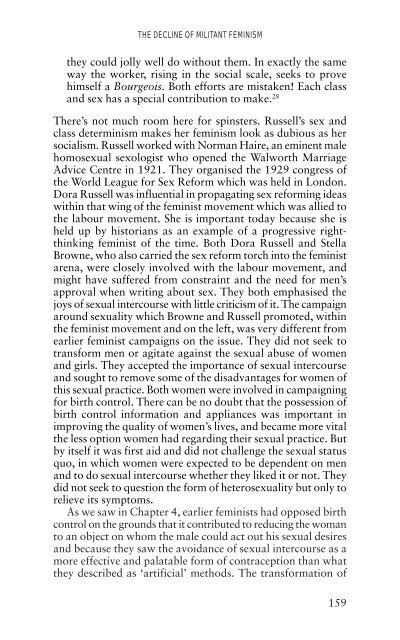The Spinster and Her Enemies - Feminish
The Spinster and Her Enemies - Feminish
The Spinster and Her Enemies - Feminish
Create successful ePaper yourself
Turn your PDF publications into a flip-book with our unique Google optimized e-Paper software.
THE DECLINE OF MILITANT FEMINISM<br />
they could jolly well do without them. In exactly the same<br />
way the worker, rising in the social scale, seeks to prove<br />
himself a Bourgeois. Both efforts are mistaken! Each class<br />
<strong>and</strong> sex has a special contribution to make. 28<br />
<strong>The</strong>re’s not much room here for spinsters. Russell’s sex <strong>and</strong><br />
class determinism makes her feminism look as dubious as her<br />
socialism. Russell worked with Norman Haire, an eminent male<br />
homosexual sexologist who opened the Walworth Marriage<br />
Advice Centre in 1921. <strong>The</strong>y organised the 1929 congress of<br />
the World League for Sex Reform which was held in London.<br />
Dora Russell was influential in propagating sex reforming ideas<br />
within that wing of the feminist movement which was allied to<br />
the labour movement. She is important today because she is<br />
held up by historians as an example of a progressive rightthinking<br />
feminist of the time. Both Dora Russell <strong>and</strong> Stella<br />
Browne, who also carried the sex reform torch into the feminist<br />
arena, were closely involved with the labour movement, <strong>and</strong><br />
might have suffered from constraint <strong>and</strong> the need for men’s<br />
approval when writing about sex. <strong>The</strong>y both emphasised the<br />
joys of sexual intercourse with little criticism of it. <strong>The</strong> campaign<br />
around sexuality which Browne <strong>and</strong> Russell promoted, within<br />
the feminist movement <strong>and</strong> on the left, was very different from<br />
earlier feminist campaigns on the issue. <strong>The</strong>y did not seek to<br />
transform men or agitate against the sexual abuse of women<br />
<strong>and</strong> girls. <strong>The</strong>y accepted the importance of sexual intercourse<br />
<strong>and</strong> sought to remove some of the disadvantages for women of<br />
this sexual practice. Both women were involved in campaigning<br />
for birth control. <strong>The</strong>re can be no doubt that the possession of<br />
birth control information <strong>and</strong> appliances was important in<br />
improving the quality of women’s lives, <strong>and</strong> became more vital<br />
the less option women had regarding their sexual practice. But<br />
by itself it was first aid <strong>and</strong> did not challenge the sexual status<br />
quo, in which women were expected to be dependent on men<br />
<strong>and</strong> to do sexual intercourse whether they liked it or not. <strong>The</strong>y<br />
did not seek to question the form of heterosexuality but only to<br />
relieve its symptoms.<br />
As we saw in Chapter 4, earlier feminists had opposed birth<br />
control on the grounds that it contributed to reducing the woman<br />
to an object on whom the male could act out his sexual desires<br />
<strong>and</strong> because they saw the avoidance of sexual intercourse as a<br />
more effective <strong>and</strong> palatable form of contraception than what<br />
they described as ‘artificial’ methods. <strong>The</strong> transformation of<br />
159

















